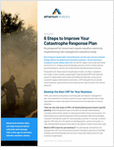 | The growing number of natural disasters in the U.S. aren’t just wreaking havoc on people’s commercial and personal property, they also make a direct hit on the insurance ecosystem. The increased workload continues to press insurers’ already strained resources. However, superior pre-planning can help you stay ahead of any crisis, which is why a catastrophe response plan (CRP) is crucial. Also known as a business continuity plan or a disaster management plan, a CRP can help you assess growth in catastrophe-prone areas and efficiently allocate resources to support your customers. Download this white paper now to learn about six key steps you need to consider when developing a CRP. Even though every insurer’s CRP should differ based on region and risk, these items are universal and will ensure you’re prepared. They include:
Make sure you have the processes and procedures in place to reduce the chaos inherent with natural disasters so you can better serve your customers during an emergency. Request Free! |
